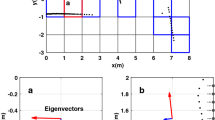Abstract
The solution to the simultaneous localization and map building (SLAM) problem where an autonomous vehicle starts in an unknown location in an unknown environment and then incrementally build a map of landmarks present in this environment while simultaneously using this map to compute absolute vehicle location is now well understood. Although a number of SLAM implementations have appeared in the recent literature, the need to maintain the knowledge of the relative relationships between all the landmark location estimates contained in the map makes SLAM computationally intractable in implementations containing more than a few tens of landmarks. This paper presents the theoretical basis and a practical implementation of a feature selection strategy that significantly reduces the computation requirements for SLAM. The paper shows that it is indeed possible to remove a large percentage of the landmarks from the map without making the map building process statistically inconsistent. Furthermore, it is shown that the computational cost of the SLAM algorithm can be reduced by judicious selection of landmarks to be preserved in the map.
Similar content being viewed by others
Explore related subjects
Discover the latest articles, news and stories from top researchers in related subjects.References
Bailey, T., Nebot, E., Rosenblatt, J., and Durrant-Whyte, H. 1999. Robust distinctive place recognition for topological maps. In International Conference of Field and Service Robotics, Pittsburgh, USA, pp. 347–352.
Bar-Shalom, Y. and Fortman, T. 1988. Tracking and Data Association. Academic Press: New York.
Castellanos, J., Montiel, J., Neira, J., and Tardos, J. 1999. Sensor influence in the performance of simultaneous mobile robot localization and map building. In Proc. 6th International Symposium on Experimental Robotics, Sydney, Australia, pp. 203–212.
Chong, K. and Kleeman, L. 1998. Large scale sonarray mapping using multiple connected local maps. In Field and Service Robotics,A. Zelinsky (Ed.), Springer-Verlag: Berlin, pp. 507–514.
Clark, S. and Dissanayake, G. 1999. Simultaneous localization and map building using millimeter wave radar to extract natural features. In Proc. IEEE Int. Conf. Robotics and Automation, Detroit, USA, pp. 1316–1321.
Csorba, M. 1997. Simultaneous localization and map building. Ph.D. Thesis, University of Oxford.
Csorba, M. and Durrant-Whyte, H. 1997. New approach to map building using relative position estimates. In Proc. of SPIE: Navigation and Control Technologies for Unmanned Systems II, Vol. 3087, The International Society for Optical Engineering, pp. 115–125.
Davison, A. 1998. Mobile robot navigation using active vision. Ph.D. Thesis, University of Oxford.
Dissanayake, M., Newman, P., Clark, S., Durrant-Whyte, H., and Csobra, M. 2001. A solution to the simultaneous localization and map building (SLAM) problem. In IEEE Trans. Robotics and Automation, 17(3):229–241.
Durrant-Whyte, H. 1996. An autonomous guided vehicle for cargo handling applications. Internation Journal of Robotics Research, 15(5):407–440.
Feder, H. 1999. Simultaneous stochastic mapping and localization. Ph.D. Thesis, Massachusetts Institute of Technology, Dept of Mechanical Engineering.
Gibbens, P., Dissanayake, M., and Durrant-Whyte, H. 2000. Aclosed form solution to the single degree of freedom simultaneous localization and map building (SLAM) problem. In Proc. IEEE Conference on Decision and Control, Vol. 1, pp. 191–196, IEEE.
Guivant, J. and Nebot, E. 2001. Optimization of the simultaneous localization and map building algorithm for real time implementation. In IEEE Transactions on Robotics and Automation, 17(3): 242–257.
Leonard, J. and Durrant-Whyte, H. 1992. Directed Sonar Sensing for Mobile Robot Navigation, Kluwer Academic Publishers: Norwell, MA.
Leonard, J. and Feder, H. 1999a. A computationally efficient method for large-scale concurrent mapping and localization. In Ninth International Symposium on Robotics Research, Utah, USA, pp. 316–321.
Leonard, J. and Feder, H. 1999b. Experimental analysis of adaptive concurrent mapping and localization using sonar. In Proc. 6th International Symposium on Experimental Robotics, Sydney, Australia, pp. 213–222.
Maybeck, P. 1982. Stochastic Models, Estimation and Control,Vol. 1, Academic Press: New York.
Newman, P. 1999. On the structure and solution of the simultaneous localization and map building problem. Ph.D. Thesis, University of Sydney, Australian Centre for Field Robotics.
Uhlmann, J., Julier, S., and Csorba, M. 1997. Nondivergent simultaneous map building and localization using covariance intersection. In Proc. of SPIE: Navigation and Control Technologies for Unmanned Systems II, Vol. 3087, The International Society for Optical Engineering, pp. 2–11.
Williams, S. 2001. Efficient solutions to autonomous mapping and navigation problems. Ph.D. Thesis, University of Sydney, Australian Centre for Field Robotics.
Williams, S., Dissanayake, G., and Durrant-Whyte, H. 2001. Towards Terrain-Aided navigation for underwater robotics. Advanced Robotics, 15(5):533–550.
Author information
Authors and Affiliations
Rights and permissions
About this article
Cite this article
Dissanayake, G., Williams, S.B., Durrant-Whyte, H. et al. Map Management for Efficient Simultaneous Localization and Mapping (SLAM). Autonomous Robots 12, 267–286 (2002). https://doi.org/10.1023/A:1015217631658
Issue Date:
DOI: https://doi.org/10.1023/A:1015217631658




